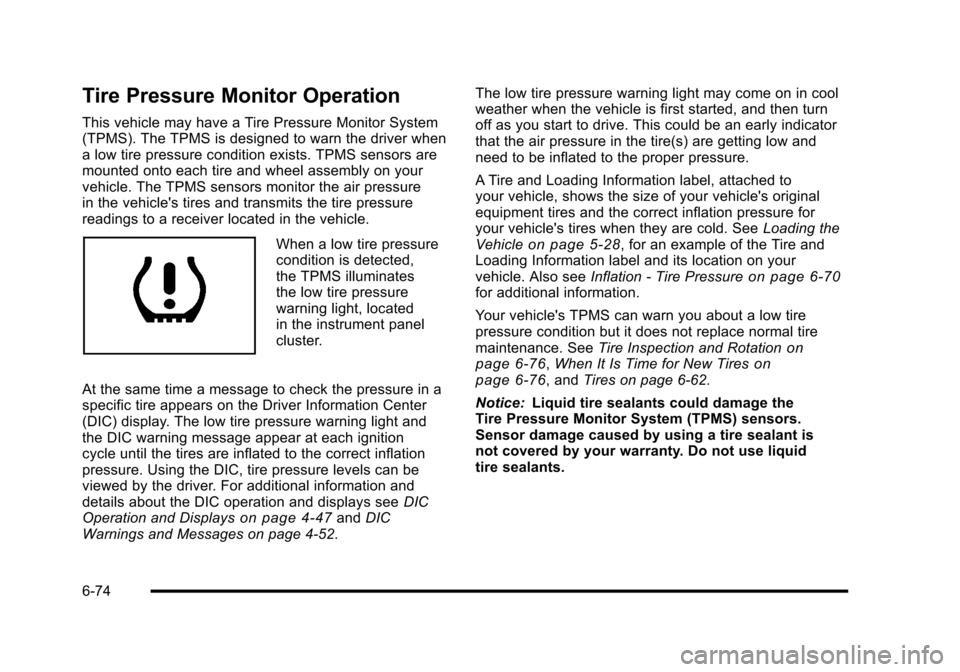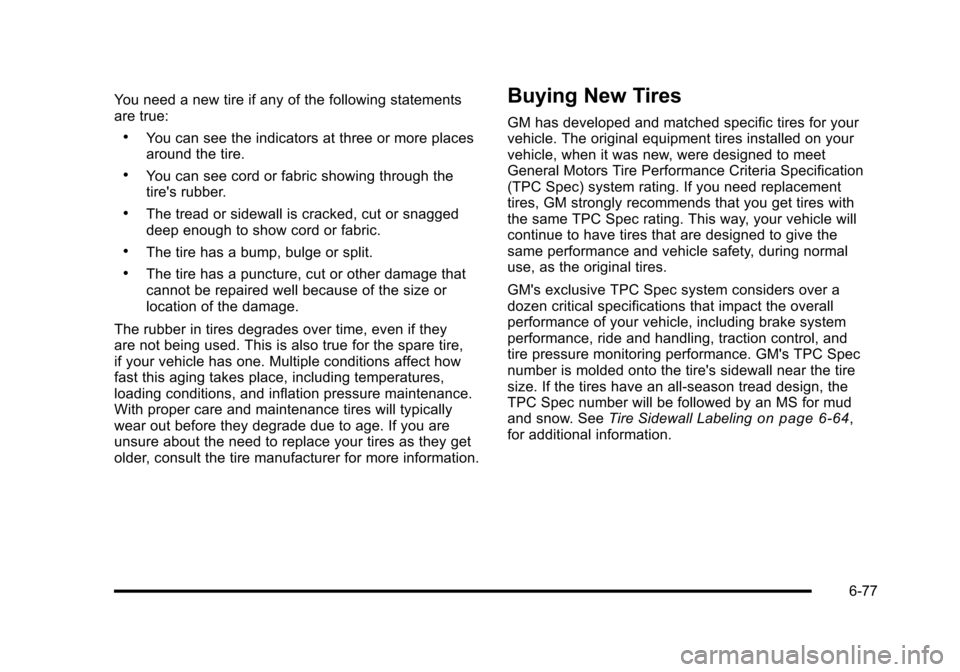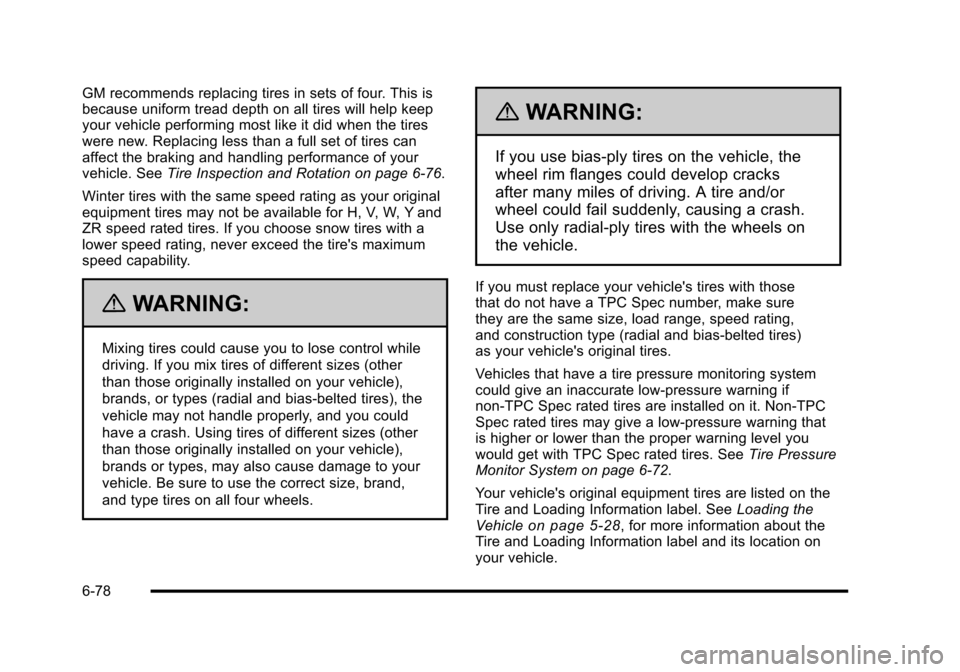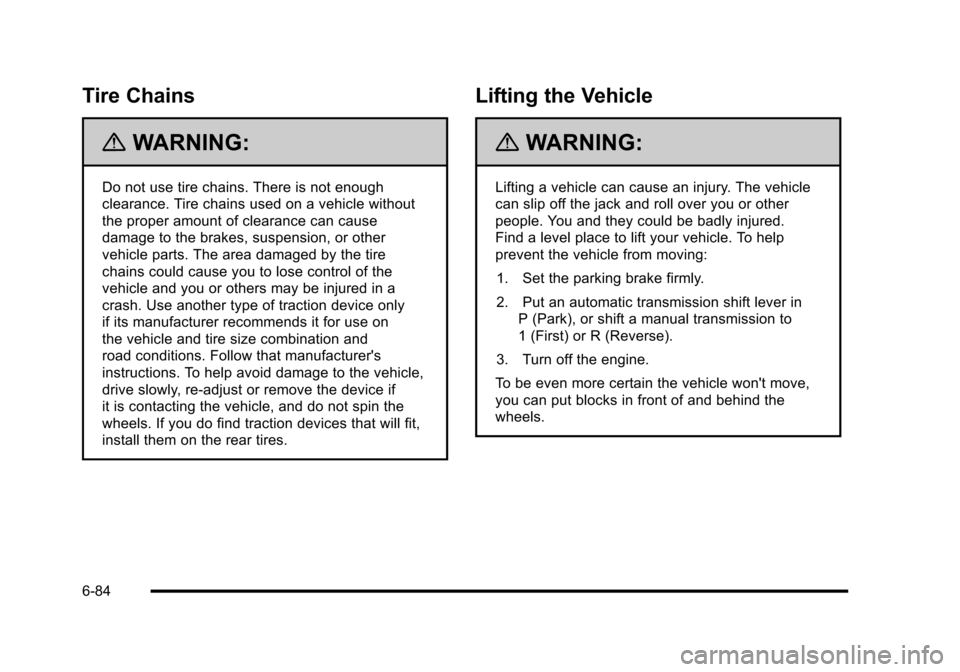2010 CHEVROLET CORVETTE tire size
[x] Cancel search: tire sizePage 386 of 472

Tire Pressure Monitor Operation
This vehicle may have a Tire Pressure Monitor System
(TPMS). The TPMS is designed to warn the driver when
a low tire pressure condition exists. TPMS sensors are
mounted onto each tire and wheel assembly on your
vehicle. The TPMS sensors monitor the air pressure
in the vehicle's tires and transmits the tire pressure
readings to a receiver located in the vehicle.
When a low tire pressure
condition is detected,
the TPMS illuminates
the low tire pressure
warning light, located
in the instrument panel
cluster.
At the same time a message to check the pressure in a
specific tire appears on the Driver Information Center
(DIC) display. The low tire pressure warning light and
the DIC warning message appear at each ignition
cycle until the tires are inflated to the correct inflation
pressure. Using the DIC, tire pressure levels can be
viewed by the driver. For additional information and
details about the DIC operation and displays see DIC
Operation and Displays
on page 4‑47and DIC
Warnings and Messages on page 4‑52. The low tire pressure warning light may come on in cool
weather when the vehicle is first started, and then turn
off as you start to drive. This could be an early indicator
that the air pressure in the tire(s) are getting low and
need to be inflated to the proper pressure.
A Tire and Loading Information label, attached to
your vehicle, shows the size of your vehicle's original
equipment tires and the correct inflation pressure for
your vehicle's tires when they are cold. See
Loading the
Vehicle
on page 5‑28, for an example of the Tire and
Loading Information label and its location on your
vehicle. Also see Inflation - Tire Pressure
on page 6‑70for additional information.
Your vehicle's TPMS can warn you about a low tire
pressure condition but it does not replace normal tire
maintenance. See Tire Inspection and Rotation
on
page 6‑76, When It Is Time for New Tireson
page 6‑76, and Tires on page 6‑62.
Notice: Liquid tire sealants could damage the
Tire Pressure Monitor System (TPMS) sensors.
Sensor damage caused by using a tire sealant is
not covered by your warranty. Do not use liquid
tire sealants.
6-74
Page 388 of 472

Tire Inspection and Rotation
We recommend that you regularly inspect your
vehicle's tires for signs of wear or damage Also
check for damaged wheels. See When It Is Time
for New Tires
on page 6‑76and Wheel
Replacement
on page 6‑81.
The tires on your vehicle are different sizes front
to rear. Due to this, the tires should not be rotated.
Each tire and wheel should be used only in the
position it is in.
When It Is Time for New Tires
Various factors, such as maintenance, temperatures,
driving speeds, vehicle loading, and road conditions,
influence when you need new tires.
One way to tell when it is
time for new tires is to
check the treadwear
indicators, which will
appear when your tires
have only 1/16 inch
(1.6 mm) or less of
tread remaining.
6-76
Page 389 of 472

You need a new tire if any of the following statements
are true:
.You can see the indicators at three or more places
around the tire.
.You can see cord or fabric showing through the
tire's rubber.
.The tread or sidewall is cracked, cut or snagged
deep enough to show cord or fabric.
.The tire has a bump, bulge or split.
.The tire has a puncture, cut or other damage that
cannot be repaired well because of the size or
location of the damage.
The rubber in tires degrades over time, even if they
are not being used. This is also true for the spare tire,
if your vehicle has one. Multiple conditions affect how
fast this aging takes place, including temperatures,
loading conditions, and inflation pressure maintenance.
With proper care and maintenance tires will typically
wear out before they degrade due to age. If you are
unsure about the need to replace your tires as they get
older, consult the tire manufacturer for more information.
Buying New Tires
GM has developed and matched specific tires for your
vehicle. The original equipment tires installed on your
vehicle, when it was new, were designed to meet
General Motors Tire Performance Criteria Specification
(TPC Spec) system rating. If you need replacement
tires, GM strongly recommends that you get tires with
the same TPC Spec rating. This way, your vehicle will
continue to have tires that are designed to give the
same performance and vehicle safety, during normal
use, as the original tires.
GM's exclusive TPC Spec system considers over a
dozen critical specifications that impact the overall
performance of your vehicle, including brake system
performance, ride and handling, traction control, and
tire pressure monitoring performance. GM's TPC Spec
number is molded onto the tire's sidewall near the tire
size. If the tires have an all‐season tread design, the
TPC Spec number will be followed by an MS for mud
and snow. See Tire Sidewall Labeling
on page 6‑64,
for additional information.
6-77
Page 390 of 472

GM recommends replacing tires in sets of four. This is
because uniform tread depth on all tires will help keep
your vehicle performing most like it did when the tires
were new. Replacing less than a full set of tires can
affect the braking and handling performance of your
vehicle. See Tire Inspection and Rotation on page 6‑76.
Winter tires with the same speed rating as your original
equipment tires may not be available for H, V, W, Y and
ZR speed rated tires. If you choose snow tires with a
lower speed rating, never exceed the tire's maximum
speed capability.
{WARNING:
Mixing tires could cause you to lose control while
driving. If you mix tires of different sizes (other
than those originally installed on your vehicle),
brands, or types (radial and bias-belted tires), the
vehicle may not handle properly, and you could
have a crash. Using tires of different sizes (other
than those originally installed on your vehicle),
brands or types, may also cause damage to your
vehicle. Be sure to use the correct size, brand,
and type tires on all four wheels.
{WARNING:
If you use bias-ply tires on the vehicle, the
wheel rim flanges could develop cracks
after many miles of driving. A tire and/or
wheel could fail suddenly, causing a crash.
Use only radial-ply tires with the wheels on
the vehicle.
If you must replace your vehicle's tires with those
that do not have a TPC Spec number, make sure
they are the same size, load range, speed rating,
and construction type (radial and bias‐belted tires)
as your vehicle's original tires.
Vehicles that have a tire pressure monitoring system
could give an inaccurate low‐pressure warning if
non‐TPC Spec rated tires are installed on it. Non‐TPC
Spec rated tires may give a low‐pressure warning that
is higher or lower than the proper warning level you
would get with TPC Spec rated tires. See Tire Pressure
Monitor System on page 6‑72.
Your vehicle's original equipment tires are listed on the
Tire and Loading Information label. See Loading the
Vehicle
on page 5‑28, for more information about the
Tire and Loading Information label and its location on
your vehicle.
6-78
Page 391 of 472

Different Size Tires and Wheels
If you add wheels or tires that are a different size than
your original equipment wheels and tires, this may
affect the way your vehicle performs, including its
braking, ride and handling characteristics, stability,
and resistance to rollover . Additionally, if your vehicle
has electronic systems such as, antilock brakes,
traction control, and electronic stability control, the
performance of these systems can be affected.
{WARNING:
If you add different sized wheels, your vehicle
may not provide an acceptable level of
performance and safety if tires not recommended
for those wheels are selected. You may increase
the chance that you will crash and suffer serious
injury. Only use GM specific wheel and tire
systems developed for your vehicle, and have
them properly installed by a GM certified
technician.
See Buying New Tires
on page 6‑77andAccessories
and Modificationson page 6‑3for additional
information.
Uniform Tire Quality Grading
Quality grades can be found where applicable
on the tire sidewall between tread shoulder and
maximum section width. For example:
Treadwear 200 Traction AA
Temperature A
The following information relates to the system
developed by the United States National
Highway Traffic Safety Administration (NHTSA),
which grades tires by treadwear, traction, and
temperature performance. This applies only to
vehicles sold in the United States. The grades
are molded on the sidewalls of most passenger
car tires. The Uniform Tire Quality Grading
(UTQG) system does not apply to deep tread,
winter-type snow tires, space-saver, or temporary
use spare tires, tires with nominal rim diameters
of 10 to 12 inches (25 to 30 cm), or to some
limited-production tires.
6-79
Page 396 of 472

Tire Chains
{WARNING:
Do not use tire chains. There is not enough
clearance. Tire chains used on a vehicle without
the proper amount of clearance can cause
damage to the brakes, suspension, or other
vehicle parts. The area damaged by the tire
chains could cause you to lose control of the
vehicle and you or others may be injured in a
crash. Use another type of traction device only
if its manufacturer recommends it for use on
the vehicle and tire size combination and
road conditions. Follow that manufacturer's
instructions. To help avoid damage to the vehicle,
drive slowly, re‐adjust or remove the device if
it is contacting the vehicle, and do not spin the
wheels. If you do find traction devices that will fit,
install them on the rear tires.
Lifting the Vehicle
{WARNING:
Lifting a vehicle can cause an injury. The vehicle
can slip off the jack and roll over you or other
people. You and they could be badly injured.
Find a level place to lift your vehicle. To help
prevent the vehicle from moving: 1. Set the parking brake firmly.
2. Put an automatic transmission shift lever in P (Park), or shift a manual transmission to
1 (First) or R (Reverse).
3. Turn off the engine.
To be even more certain the vehicle won't move,
you can put blocks in front of and behind the
wheels.
6-84
Page 470 of 472

Securing a Child Restraint Right Front Seat Position . . . . . . . . . . . . . . . . . . . . . . . . . 2-40
Security Light . . . . . . . . . . . . . . . . . . . . . . . . . . . . . . . . . . . . . . . . . . . . . . 4-45
Selective Ride Control . . . . . . . . . . . . . . . . . . . . . . . . . . . . . 5-14
Service . . . . . . . . . . . . . . . . . . . . . . . . . . . . . . . . . . . . . . . . . . . . . .6-3 Accessories and Modifications . . . . . . . . . . . . . . . . . . . . . 6-3
Adding Equipment to the Outside of the Vehicle . . . 6-5
Doing Your Own Work . . . . . . . . . . . . . . . . . . . . . . . . . . . . . 6-5
Engine Soon Lamp . . . . . . . . . . . . . . . . . . . . . . . . . . . . . . . 4-41
Parts Identification Label . . . . . . . . . . . . . . . . . . . . . . . .6-100
Publications Ordering Information . . . . . . . . . . . . . . . . . 8-16
Scheduling Appointments . . . . . . . . . . . . . . . . . . . . . . . . . 8-10
Servicing Your Airbag-Equipped Vehicle . . . . . . . . . . . 2-58
Setting the Clock . . . . . . . . . . . . . . . . . . . . . . . . . . . . . . . . . . 4-80
Shifting Out of Park . . . . . . . . . . . . . . . . . . . . . . . . . . . . . . . . . . . . . . . 3-36
Shifting Into Park . . . . . . . . . . . . . . . . . . . . . . . . . . . . . . . . . . 3-35
Signals, Turn and Lane-Change . . . . . . . . . . . . . . . . . . . . .4-5
Specifications and Capacities . . . . . . . . . . . . . . . . . . . . . 6-108
Speedometer . . . . . . . . . . . . . . . . . . . . . . . . . . . . . . . . . . . . . . 4-32
Starting the Engine . . . . . . . . . . . . . . . . . . . . . . . . . . . . . . . . 3-24
Steering . . . . . . . . . . . . . . . . . . . . . . . . . . . . . . . . . . . . . . . . . . . 5-16
Steering Wheel Controls, Audio . . . . . . . . . . . . . . . . . . 4-107
Steering Wheel Controls, Memory . . . . . . . . . . . . . . . . . . .2-4
Steering Wheel, Tilt Wheel . . . . . . . . . . . . . . . . . . . . . . . . . .4-3 Storage Areas
Center Console . . . . . . . . . . . . . . . . . . . . . . . . . . . . . . . . . . . 3-50
Convenience Net . . . . . . . . . . . . . . . . . . . . . . . . . . . . . . . . . 3-52
Cupholders . . . . . . . . . . . . . . . . . . . . . . . . . . . . . . . . . . . . . . . 3-50
Glove Box . . . . . . . . . . . . . . . . . . . . . . . . . . . . . . . . . . . . . . . . 3-50
Rear . . . . . . . . . . . . . . . . . . . . . . . . . . . . . . . . . . . . . . . . . . . . . . 3-51
Storing the Roof Panel . . . . . . . . . . . . . . . . . . . . . . . . . . . . 3-56
Stuck in Sand, Mud, Ice, or Snow . . . . . . . . . . . . . . . . . 5-27
Sun Visors . . . . . . . . . . . . . . . . . . . . . . . . . . . . . . . . . . . . . . . . . 3-18
T
Tachometer . . . . . . . . . . . . . . . . . . . . . . . . . . . . . . . . . . . . . . . . 4-32
Taillamps
Turn Signal, and Stoplamps . . . . . . . . . . . . . . . . . . . . . . 6-58
Text Telephone (TTY) Users . . . . . . . . . . . . . . . . . . . . . . . . .8-6
Theft - Deterrent System . . . . . . . . . . . . . . . . . . . . . . . . . . 3-19
Theft-Deterrent Feature . . . . . . . . . . . . . . . . . . . . . . . . . . . 4-106
Theft-Deterrent Systems . . . . . . . . . . . . . . . . . . . . . 3-19, 3-20 Immobilizer . . . . . . . . . . . . . . . . . . . . . . . . . . . . . . . . . . . . . . . 3-20
Tilt Wheel . . . . . . . . . . . . . . . . . . . . . . . . . . . . . . . . . . . . . . . . . . . .4-3
Time, Setting . . . . . . . . . . . . . . . . . . . . . . . . . . . . . . . . . . . . . . 4-80
Tires . . . . . . . . . . . . . . . . . . . . . . . . . . . . . . . . . . . . . . . . . . . . . . . 6-62 Aluminum or Chrome-Plated Wheels, Cleaning . . . 6-97
Buying New Tires . . . . . . . . . . . . . . . . . . . . . . . . . . . . . . . . . 6-77
Chains . . . . . . . . . . . . . . . . . . . . . . . . . . . . . . . . . . . . . . . . . . . . 6-84
Cleaning . . . . . . . . . . . . . . . . . . . . . . . . . . . . . . . . . . . . . . . . . . 6-98
Different Size . . . . . . . . . . . . . . . . . . . . . . . . . . . . . . . . . . . . . 6-79
i - 12
Page 472 of 472

Vehicle Identification Number (VIN) . . . . . . . . . . . . . . . . . . . . . . . . . . . . . . . . . . . . . 6-99
Service Parts Identification Label . . . . . . . . . . . . . . . .6-100
Vehicle Personalization DIC . . . . . . . . . . . . . . . . . . . . . . . . . . . . . . . . . . . . . . . . . . . . . . . 4-71
Ventilation Adjustment . . . . . . . . . . . . . . . . . . . . . . . . . . . . . 4-27
Visors . . . . . . . . . . . . . . . . . . . . . . . . . . . . . . . . . . . . . . . . . . . . . 3-18
Voltmeter Gauge . . . . . . . . . . . . . . . . . . . . . . . . . . . . . . . . . . 4-35
W
Warning Lights, Gauges, and Indicators . . . . . . . . . . . 4-29
Warnings DIC Warnings and Messages . . . . . . . . . . . . . . . . . . . . . 4-52
Hazard Flashers . . . . . . . . . . . . . . . . . . . . . . . . . . . . . . . . . . . 4-3
Safety and Symbols . . . . . . . . . . . . . . . . . . . . . . . . . . . . . . . . . iv
Wheels Alignment and Tire Balance . . . . . . . . . . . . . . . . . . . . . . 6-81
Different Size . . . . . . . . . . . . . . . . . . . . . . . . . . . . . . . . . . . . . 6-79
Replacement . . . . . . . . . . . . . . . . . . . . . . . . . . . . . . . . . . . . . 6-81
When It Is Time for New Tires . . . . . . . . . . . . . . . . . . . . . 6-76 Windows . . . . . . . . . . . . . . . . . . . . . . . . . . . . . . . . . . . . . . . . . . 3-16
Power . . . . . . . . . . . . . . . . . . . . . . . . . . . . . . . . . . . . . . . . . . . . 3-17
Windshield Replacement . . . . . . . . . . . . . . . . . . . . . . . . . . . . . . . . . . . . . 6-59
Washer . . . . . . . . . . . . . . . . . . . . . . . . . . . . . . . . . . . . . . . . . . . . 4-6
Washer Fluid . . . . . . . . . . . . . . . . . . . . . . . . . . . . . . . . . . . . . 6-42
Wiper Blade Replacement . . . . . . . . . . . . . . . . . . . . . . . . 6-59
Wiper Blades, Cleaning . . . . . . . . . . . . . . . . . . . . . . . . . . . 6-96
Wiper Fuses . . . . . . . . . . . . . . . . . . . . . . . . . . . . . . . . . . . . .6-100
Wipers . . . . . . . . . . . . . . . . . . . . . . . . . . . . . . . . . . . . . . . . . . . . . 4-6
Winter Driving . . . . . . . . . . . . . . . . . . . . . . . . . . . . . . . . . . . . . 5-25
Winter Tires . . . . . . . . . . . . . . . . . . . . . . . . . . . . . . . . . . . . . . . 6-63
Wiper Activated Headlamps . . . . . . . . . . . . . . . . . . . . . . . 4-12
X
XM Radio Messages . . . . . . . . . . . . . . . . . . . . . . . . . . . . . . 4-95
XM™ Satellite Radio
Antenna . . . . . . . . . . . . . . . . . . . . . . . . . . . . . . . . . . . . . . . . .4-109
i - 14